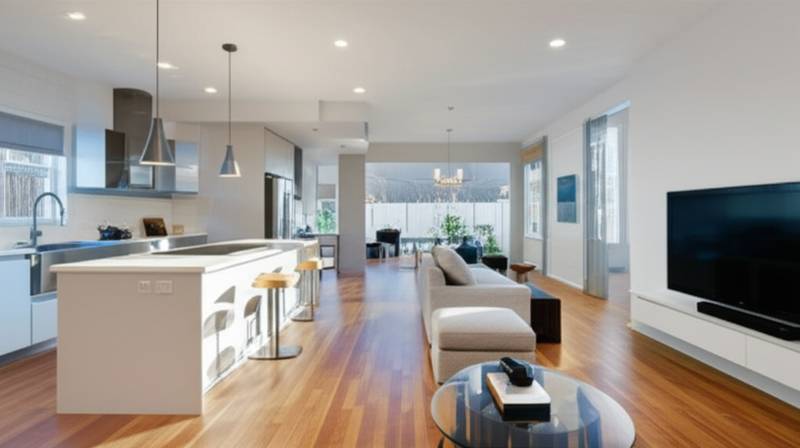Understanding Wi-Fi 6E as the Solution for Smart Home Networks
Smart homes have transitioned from optional features to essential components of daily life. Households now integrate numerous connected devices, such as lights, cameras, speakers, appliances, and sensors, which place increasing strain on traditional networks. Wi-Fi 6E emerges as the latest advancement in wireless technology, offering superior speeds, minimal latency, and additional spectrum space to prevent interference among devices. For individuals undertaking home upgrades or renovations, evaluating Wi-Fi 6E holds significance comparable to selecting appropriate flooring or lighting.
Key Distinctions of Wi-Fi 6E
Wi-Fi 6E extends beyond conventional Wi-Fi by accessing a fresh spectrum band. This addition provides expanded bandwidth, allowing devices to transmit data without mutual interference. Previous Wi-Fi standards operated mainly on two frequency bands, whereas Wi-Fi 6E incorporates a third band, resulting in reduced congestion and enhanced performance in environments with multiple devices.
Homeowners experience tangible improvements, including reduced video buffering, consistent operation of smart security cameras, and the capacity to manage numerous connected devices concurrently without performance degradation.
The Necessity of Wi-Fi 6E in Contemporary Smart Homes
A typical smart home involves a web of devices that communicate continuously. Smart thermostats relay temperature data, cameras transmit live video, locks verify status with mobile devices, and lights adapt to predefined schedules. These elements demand stable and responsive connections. Legacy Wi-Fi systems frequently falter under such demands, particularly in expansive residences or densely populated urban settings with overlapping signals.
Wi-Fi 6E mitigates these issues by providing additional pathways for data transmission. Consider a highway expanding from two lanes to six; traffic proceeds more efficiently, and overall movement accelerates. In smart homes, this capability maintains the responsiveness of a doorbell camera while a household member streams 4K content in a separate room.
Everyday Advantages of Wi-Fi 6E Implementation
The advancements in Wi-Fi 6E technology manifest in practical enhancements to routine activities:
- Uninterrupted Streaming: Increased bandwidth permits several family members to view ultra-high-definition content simultaneously without pauses.
- Immediate Automation Responses: Smart lighting sequences activate without noticeable delays.
- Dependable Security Monitoring: Exterior cameras deliver continuous video streams, unaffected by concurrent device usage.
- Enhanced Remote Productivity: Video conferences sustain clarity and stability amid a network populated with various connected gadgets.
These improvements position Wi-Fi 6E as a fundamental element for residences that depend on technology to deliver comfort, protection, and leisure.
Current Trends in Wi-Fi 6E Deployment
Market research indicates that the average number of connected devices per household rises annually. Experts predict rapid growth in Wi-Fi 6E usage, driven by the integration of this standard in upcoming smartphones, laptops, and smart home controllers. Prominent router manufacturers now offer Wi-Fi 6E-compatible units, while advanced mesh networks ensure comprehensive coverage throughout entire properties.
For instance, contemporary mesh kits facilitate uniform signal distribution across multiple levels. By leveraging Wi-Fi 6E's extended spectrum, these solutions guarantee steady speeds in every area, proving particularly beneficial for spacious homes or structures with substantial barriers like thick walls.
Potential Obstacles in Adopting Wi-Fi 6E
Despite its innovations, Wi-Fi 6E presents certain hurdles. Compatible routers and devices command higher prices than preceding generations. Moreover, only recent equipment can utilize the new spectrum, necessitating selective upgrades. Individuals might also require enhanced internet subscriptions to realize peak velocities.
Nevertheless, the enduring benefits outweigh these drawbacks. As adoption broadens, expenses will decline, rendering Wi-Fi 6E upgrades a standard consideration rather than an extravagance.
Incorporating Wi-Fi 6E into Home Design Strategies
For projects involving renovations or construction, embedding Wi-Fi 6E considerations during planning proves advantageous. Similar to accounting for electrical outlets or plumbing systems, determining ideal router positions and coverage zones aligns the network with intended living patterns. Professionals in renovations increasingly install Ethernet infrastructure or designate spaces for network equipment to safeguard against future obsolescence.
Such foresight proves essential, given that Wi-Fi 6E's elevated frequencies exhibit reduced propagation distances relative to earlier bands. Deploying mesh configurations or targeted access points becomes crucial for comprehensive coverage in larger spaces. Addressing these aspects at the outset prevents subsequent complications.
Envisioning Enhanced Living Through Wi-Fi 6E
Smart homes progress toward interconnected systems where devices collaborate intuitively. Wi-Fi 6E serves as the underlying framework enabling this synergy. Picture an automated morning sequence: blinds rise, the thermostat adjusts warmth, the coffee brews, and a personalized music selection commences, all without interruption. The low latency of Wi-Fi 6E guarantees prompt execution of each step, fostering fluid interactions.
This dependability extends to critical safety functions. Prompt alerts from smoke detectors or entry sensors can prevent emergencies. Wi-Fi 6E minimizes delays in notifications, thereby bolstering overall security and tranquility.
Steps to Upgrade to Wi-Fi 6E
To initiate a network enhancement, follow these structured actions:
- Assess Existing Equipment: Review your current devices to identify those compatible with Wi-Fi 6E. Recent smartphones and laptops often include this feature.
- Select a Compatible Router: Opt for a model supporting Wi-Fi 6E, even if immediate device utilization is limited; this prepares the system for gradual expansions.
- Design for Optimal Coverage: In larger homes, consider mesh networks or additional access points. Evaluate high-usage areas and smart device placements.
- Align Investments with Needs: Prioritize the upgrade if streaming, automation, or security forms a core part of your smart home setup, yielding swift returns.
Building a Foundation for Connected Living
As connectivity permeates residences, the network assumes infrastructure status akin to utilities. Wi-Fi 6E transcends mere speed enhancements; it cultivates spaces where technology amplifies ease, safeguards assets, and streamlines operations unobtrusively. Homeowners, renovators, and architects should extend their focus beyond visible elements to the essential connectivity layer that animates contemporary lifestyles.
The evolution of smart homes demands robust support for emerging devices and interactions. Embracing Wi-Fi 6E positions properties for sustained performance, where seamless integration and responsive intelligence define the living experience.
